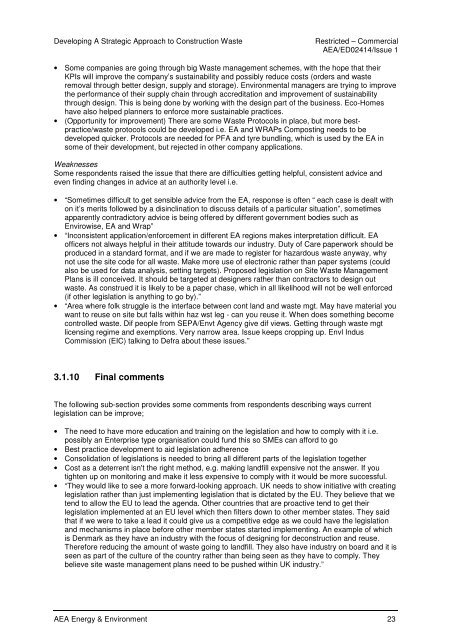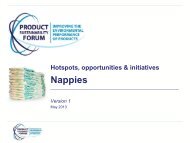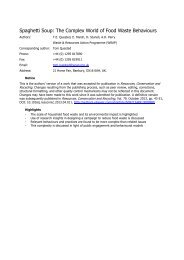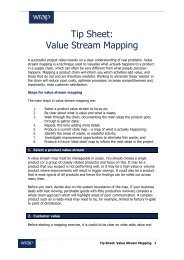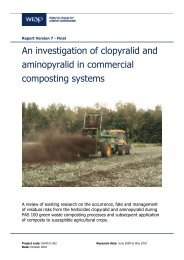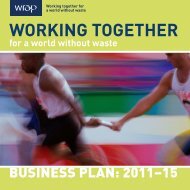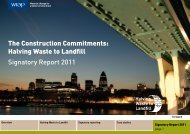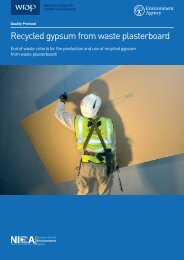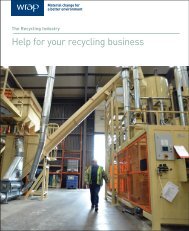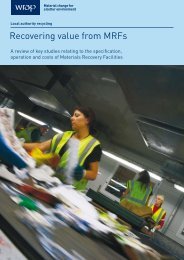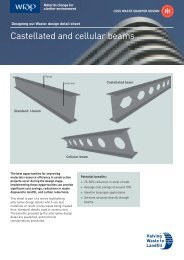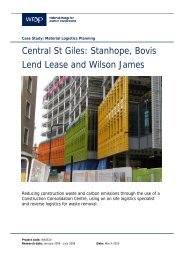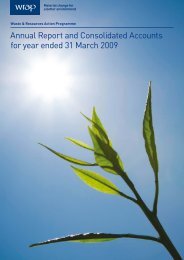Developing a Strategic Approach to Construction Waste
Developing a Strategic Approach to Construction Waste
Developing a Strategic Approach to Construction Waste
You also want an ePaper? Increase the reach of your titles
YUMPU automatically turns print PDFs into web optimized ePapers that Google loves.
<strong>Developing</strong> A <strong>Strategic</strong> <strong>Approach</strong> <strong>to</strong> <strong>Construction</strong> <strong>Waste</strong>Restricted – CommercialAEA/ED02414/Issue 1• Some companies are going through big <strong>Waste</strong> management schemes, with the hope that theirKPIs will improve the company’s sustainability and possibly reduce costs (orders and wasteremoval through better design, supply and s<strong>to</strong>rage). Environmental managers are trying <strong>to</strong> improvethe performance of their supply chain through accreditation and improvement of sustainabilitythrough design. This is being done by working with the design part of the business. Eco-Homeshave also helped planners <strong>to</strong> enforce more sustainable practices.• (Opportunity for improvement) There are some <strong>Waste</strong> Pro<strong>to</strong>cols in place, but more bestpractice/wastepro<strong>to</strong>cols could be developed i.e. EA and WRAPs Composting needs <strong>to</strong> bedeveloped quicker. Pro<strong>to</strong>cols are needed for PFA and tyre bundling, which is used by the EA insome of their development, but rejected in other company applications.WeaknessesSome respondents raised the issue that there are difficulties getting helpful, consistent advice andeven finding changes in advice at an authority level i.e.• “Sometimes difficult <strong>to</strong> get sensible advice from the EA, response is often “ each case is dealt withon it’s merits followed by a disinclination <strong>to</strong> discuss details of a particular situation”, sometimesapparently contradic<strong>to</strong>ry advice is being offered by different government bodies such asEnvirowise, EA and Wrap”• “Inconsistent application/enforcement in different EA regions makes interpretation difficult. EAofficers not always helpful in their attitude <strong>to</strong>wards our industry. Duty of Care paperwork should beproduced in a standard format, and if we are made <strong>to</strong> register for hazardous waste anyway, whynot use the site code for all waste. Make more use of electronic rather than paper systems (couldalso be used for data analysis, setting targets). Proposed legislation on Site <strong>Waste</strong> ManagementPlans is ill conceived. It should be targeted at designers rather than contrac<strong>to</strong>rs <strong>to</strong> design outwaste. As construed it is likely <strong>to</strong> be a paper chase, which in all likelihood will not be well enforced(if other legislation is anything <strong>to</strong> go by).”• “Area where folk struggle is the interface between cont land and waste mgt. May have material youwant <strong>to</strong> reuse on site but falls within haz wst leg - can you reuse it. When does something becomecontrolled waste. Dif people from SEPA/Envt Agency give dif views. Getting through waste mgtlicensing regime and exemptions. Very narrow area. Issue keeps cropping up. Envl IndusCommission (EIC) talking <strong>to</strong> Defra about these issues.”3.1.10 Final commentsThe following sub-section provides some comments from respondents describing ways currentlegislation can be improve;• The need <strong>to</strong> have more education and training on the legislation and how <strong>to</strong> comply with it i.e.possibly an Enterprise type organisation could fund this so SMEs can afford <strong>to</strong> go• Best practice development <strong>to</strong> aid legislation adherence• Consolidation of legislations is needed <strong>to</strong> bring all different parts of the legislation <strong>to</strong>gether• Cost as a deterrent isn't the right method, e.g. making landfill expensive not the answer. If youtighten up on moni<strong>to</strong>ring and make it less expensive <strong>to</strong> comply with it would be more successful.• “They would like <strong>to</strong> see a more forward-looking approach. UK needs <strong>to</strong> show initiative with creatinglegislation rather than just implementing legislation that is dictated by the EU. They believe that wetend <strong>to</strong> allow the EU <strong>to</strong> lead the agenda. Other countries that are proactive tend <strong>to</strong> get theirlegislation implemented at an EU level which then filters down <strong>to</strong> other member states. They saidthat if we were <strong>to</strong> take a lead it could give us a competitive edge as we could have the legislationand mechanisms in place before other member states started implementing. An example of whichis Denmark as they have an industry with the focus of designing for deconstruction and reuse.Therefore reducing the amount of waste going <strong>to</strong> landfill. They also have industry on board and it isseen as part of the culture of the country rather than being seen as they have <strong>to</strong> comply. Theybelieve site waste management plans need <strong>to</strong> be pushed within UK industry.”AEA Energy & Environment 23


